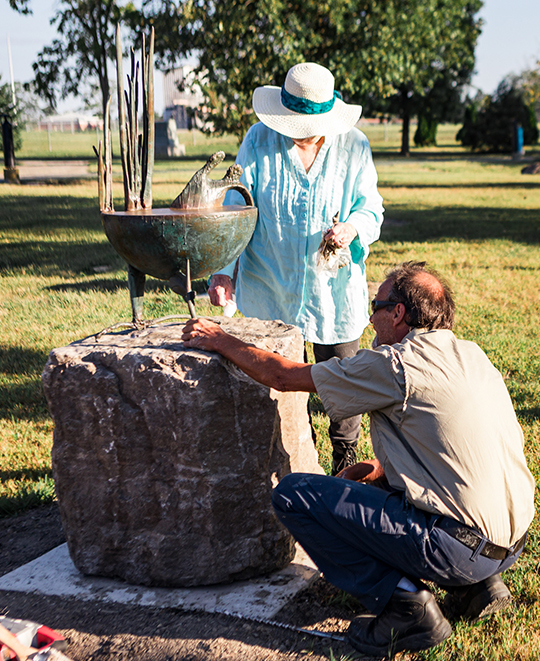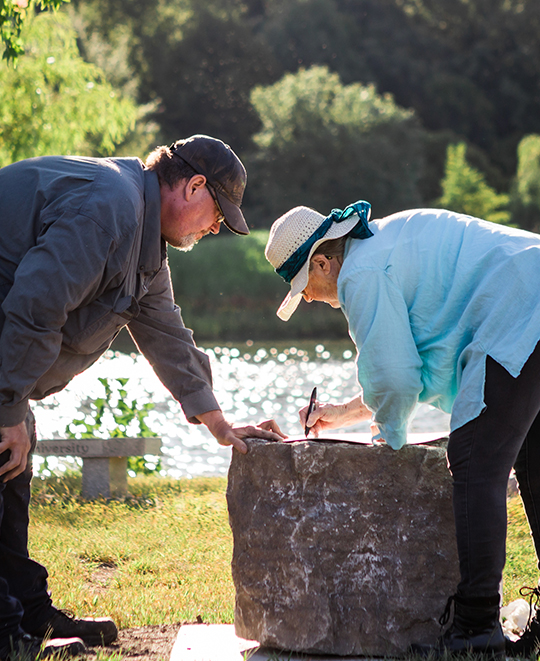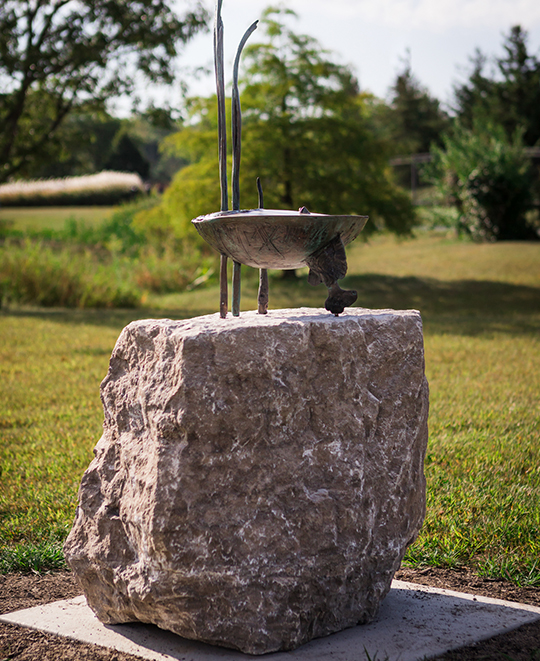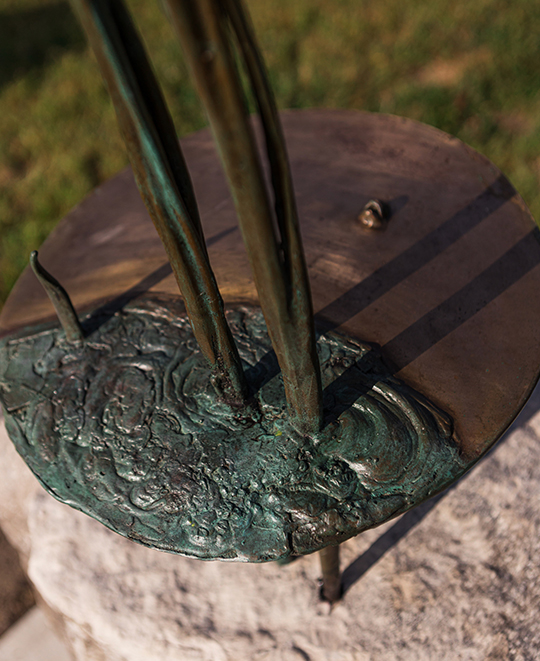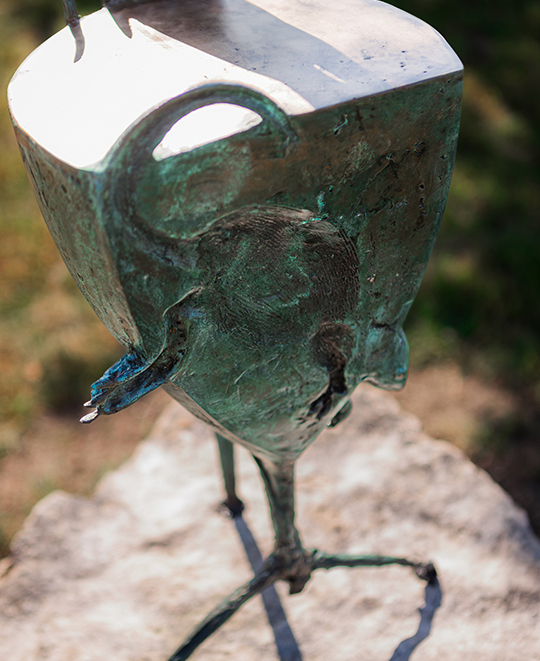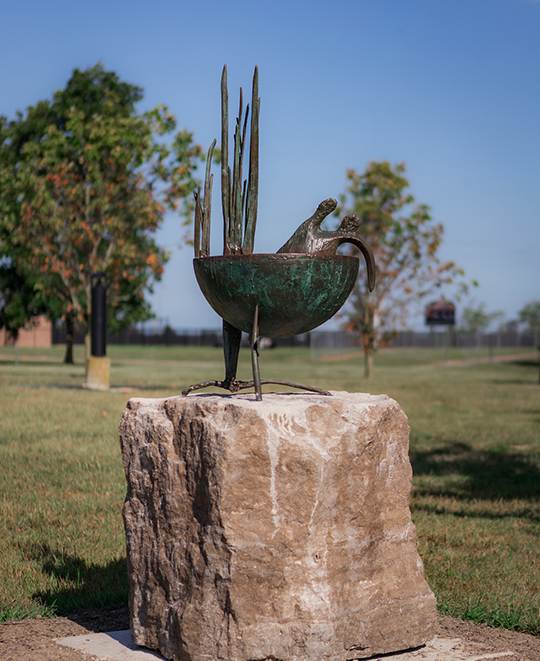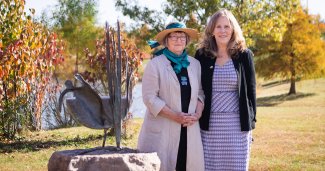
The life of a pond inspires new sculptures on campus
Retired ONU art professor donates artwork.
Judith Greavu is sharing her love of art and nature with a gift of four sculptures to Ohio Northern University. ONU held a dedication ceremony for the sculptures on October 22.
The sculptures, which were inspired by the water, plant life, and creatures in a pond on Greavu’s property near Dola, were installed close to the wetland pond on west campus.
Greavu, a nationally known sculptor who taught in the ONU Art Department from 1985 to 2005, literally immersed herself in the pond that inspired these sculptures.
“The sculptures for me evoke all kinds of memories of being in that environment, not just watching it,” she said.
Professor Terry Keiser, who taught biology at ONU for 50 years, advised Greavu when she built her pond, suggesting she put in a few catfish, bass, bluegill, and other fish.
“The catfish grew huge; they became pets like cats,” she said. “When I would walk into the water at the beach end to swim to the deep end, they would be right beside me, swimming around me …like cats do when they wanted to be fed.”
She also went into the pond regularly to clear out invasive, choking water weeds by hand. Because she loves the environment, she explained, “I refused to use herbicides on the pond.”
The muskrats that live in the pond also figure in the sculptures she’s presenting to Ohio Northern. Initially, she said, she was advised to trap and kill the muskrats because they burrowed in the mud, and the mud would then fill the pond. She tried that and didn’t like it. “I decided I can’t do that anymore so we just let them be. I could watch them swim back and forth across the pond and they were just a part of it.”
Greavu’s love of art and the natural environment started when she was growing up in Florida.
“Always, from the time I was a little child, I remember making drawings. I never thought of doing anything else.”
When her family moved to a rural area outside of town, she became fascinated with the amazing number of insects, spiders, snakes, and birds surrounding her home. Florida’s abundant water – the ocean, springs, rivers, and ponds also influenced her.
She came to Ohio to attend Urbana Junior College, an experimental educational institution in the 1960s. From there, she went to Ball State University in Indiana.
“It was a teacher’s college, so that was mainly what the program was.” But the courses for the BS in art education had all the requirements of a school that offered a BFA, she said. She went on to eventually earn an MFA in painting from Bowling Green State University.
Greavu is now rooted in Ohio. She taught at ONU for over 20 years, and her husband, Bruce Chesser, is also a retired ONU art professor who taught for 32 years. They now live near Bluffton. She has two grown daughters, one living in Parma and one in Ireland.
Along the way as she studied art, she discovered her love of sculpture in a metal casting course.
She found the process of making a bronze sculpture intriguing because of all the steps involved. However, at the end of the course when it was time to pour the metal into the mold, the women weren’t allowed into the room.
“That kind of ticked me off so I said, ‘I will do this myself, and I did.’”
Bronze and glass are among her favorite materials.
Bronze is a wonderful material to work with she said, because it offers so many possibilities. “Part of it is the process, the many steps you have to go through.” It’s also the color, she added. “There’s such a range…you can polish it to a soft golden glow or just polish some of it.” The copper in bronze can also react with chemicals to bring out greens or blues.
Glass provides a good way to reflect the waters that are an essential part of her work.
She’s recently completed a series that focuses on the Florida’s beautiful natural springs. These pieces will be displayed at the Gillespie Museum at Stetson University in Florida for six months. “This whole series deals with that environment and the threat to it,” she said.
She is an ardent advocate for the role of the arts in education. Many of the students she taught at Ohio Northern were going into graphic design, a practical application of art, but “the principles I would teach them, the basic design and aesthetic” would serve them well in other fields, she said. And, even as schools place a heavy emphasis on STEM (science, technology, engineering and mathematics), preparing art teachers is also critical, Greavu said. She encourages a STEAM approach, adding arts to the acronym.
“It’s important to make that kind of expression available to school children.” Some children may be nonverbal or need alternative ways to share their thoughts, she added. “Putting words together doesn’t come easily, but there are different ways of expressing very real thoughts and feelings and analysis that are going to come out through music and visual arts.”
